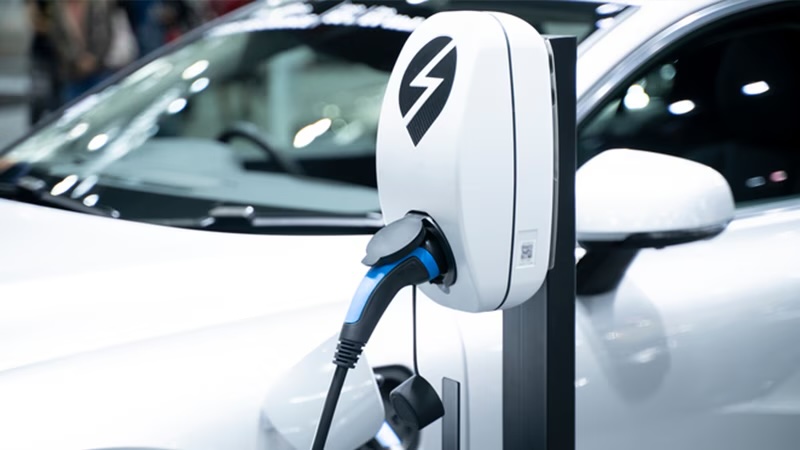Electric vehicle battery prices are expected to fall 50% by 2026
Technology advances that have allowed electric vehicle battery makers to increase energy density, combined with a drop in green metal prices, will push battery prices lower than previously expected, according to Goldman Sachs Research.
Global average battery prices declined from $153 per kilowatt-hour (kWh) in 2022 to $149 in 2023, and they’re projected by Goldman Sachs Research to fall to $111 by the close of this year. Our researchers forecast that average battery prices could fall towards $80/kWh by 2026, amounting to a drop of almost 50% from 2023, a level at which battery electric vehicles would achieve ownership cost parity with gasoline-fueled cars in the US on an unsubsidized basis.

We spoke with Nikhil Bhandari, co-head of Goldman Sachs Research’s Asia-Pacific Natural Resources and Clean Energy Research, to better understand what’s driving the decline in battery prices and what it means for EV demand and adoption.
Why are EV battery prices coming down faster than expected?
There are two main drivers. One is technological innovation. We’re seeing multiple new battery products that have been launched that feature about 30% higher energy density and lower cost.
The second driver is a continued downturn in battery metal prices. That includes lithium and cobalt, and nearly 60% of the cost of batteries is from metals. When we talk about the battery from, let’s say, 2023 to all the way to 2030, roughly over 40% of the decline is just coming from lower commodity costs, because we had a lot of green inflation during 2020 to 2023. The level of those metal prices was very high.
What’s enabling battery makers to increase energy density so dramatically?
The innovation is related to the structure of the batteries. The cells are getting bigger. You normally pack lots of cells into smaller modules, and then lots of modules into a big battery pack. Now they’re trying to eliminate modules and directly doing cell-to-pack. That helps you save a bit of space inside. So you’re cutting costs with more simplified structures and increasing the energy of the battery at the same time.
Which battery types are dominating right now?
Both the leading battery types are lithium-based. One is based on nickel chemistry, which dominates nearly 60% of the market for different types of nickel batteries. And the other leading type – LFP (lithium ferrophosphate) – is iron-based. They’re capturing about 35-40% of the market. Then there is a very small share coming from another technology called sodium ion. It’s the only non-lithium battery, but a very small quantity of such batteries are being produced today, and it’s not scaled up yet.
Do you expect the leading battery types to stave off the competition?
In the future, we’ll be talking about solid state batteries, which could be a real game changer, because the technology can increase your energy density more materially and is slightly safer because there is no flammable liquid electrolyte. We were assuming that newer batteries like solid state would capture about 5-10% of the market along with sodium ion batteries, but that hasn’t happened. Solid state was initially supposed to come out by now, and it’s been pushed out to the later part of this decade because of challenges in moving from lab scale to mass production.
In the meantime, the existing lithium-based chemistries are going to get stronger and stronger, and that’s going to make it difficult for solid state batteries to eventually replace the existing technology. We have actually raised our expectation for LFP batteries to increase their market share from 41% of the market to 45% in 2025, with advanced nickel batteries continuing to dominate the higher energy competition.
What does this mean for incumbent battery producers?
There are multiple reasons why the entry barrier in the battery industry is high. It takes about 10 years between startup R&D and first production. And it takes even more time to achieve a good level of quality. Mass production is another skillset altogether. We’ve seen companies that have been operating in the industry for 10 to 15 years, but they’re not EBITDA- breakeven yet. Even when you can start producing, it takes time to get a good level of yield of output and a good cost structure. The third challenge has been finding skilled labor in this industry.
There are five companies which control nearly 80% of the market share. Each has been in the industry for over two decades, and they’ve intensified their R&D spend even more aggressively in the last three to five years. That is creating a vicious cycle that is making it tough for anyone else to compete. Newer entrants are coming into the market during a cyclical downturn, and many are finding it difficult to survive given that they haven’t achieved the right level of manufacturing efficiency.
Will the decline in battery prices rekindle EV demand?
When we looked at price parity with ICE (internal combustion engine) cars, we typically looked at the price premium a consumer will pay for an EV in terms of how long it will take to recover it through fuel cost savings. What we didn’t account for, historically, is another concern that the consumer has. Resale values of EVs are falling faster because consumers are thinking they can buy a cheaper EV maybe three years from now.
We account for this in our recent enhanced total cost of ownership analysis. But given that we’re still expecting a rapid fall in battery prices, and assuming a still relatively elevated oil price environment, we believe that, in markets such as the US, the total cost of ownership parity will still arrive starting in 2026. Admittedly, that leaves near-term EV battery demand more dependent on regulations, especially next year. But we think we’re going to see a strong comeback in demand in 2026 purely from an economics perspective. We believe 2026 is when a consumer-led adoption phase will largely begin.
This article is being provided for educational purposes only. The information contained in this article does not constitute a recommendation from any Goldman Sachs entity to the recipient, and Goldman Sachs is not providing any financial, economic, legal, investment, accounting, or tax advice through this article or to its recipient. Neither Goldman Sachs nor any of its affiliates makes any representation or warranty, express or implied, as to the accuracy or completeness of the statements or any information contained in this article and any liability therefore (including in respect of direct, indirect, or consequential loss or damage) is expressly disclaimed.


